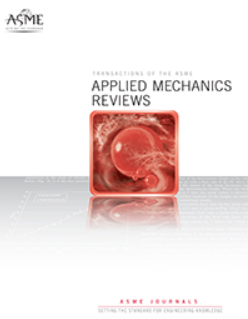旋转对称折纸:力学与设计综述
IF 16.1
1区 工程技术
Q1 MECHANICS
引用次数: 13
摘要
折纸已经成为设计功能可折叠和可展开结构的强大机制。在各种折纸图案中,有很大一类折纸图案表现为旋转对称,具有几何形状优美、收缩/膨胀轴对称、可全方位展开等优点。由于这些优点,具有旋转对称性的折纸在各种工程领域得到了广泛的应用,如可折叠的应急避难所、可变形的轮子、可展开的医疗支架和可展开的太阳能电池板。为了指导基于折纸的可展开结构和功能装置的合理设计,近年来人们对旋转对称折纸的几何设计和力学行为进行了大量的研究。本文将具有旋转对称性的折纸结构根据其展开和折叠状态之间的维度转换分为三维到三维、三维到二维和二维到二维三种类型。在这三类的基础上,我们系统地回顾了它们的折纸图案的几何设计以及它们在折叠运动中的力学行为。总结了现有的分析和设计折纸结构的理论和数值方法。讨论了旋转对称折纸力学及其应用的潜在方向和未来挑战。这一综述可以为旋转对称折纸在更大范围的长度尺度上实现更多功能的应用提供指导。本文章由计算机程序翻译,如有差异,请以英文原文为准。
Origami with Rotational Symmetry: A Review on Their Mechanics and Design
Origami has emerged as a powerful mechanism for designing functional foldable and deployable structures. Among various origami patterns, a large class of origami exhibits rotational symmetry, which possesses the advantages of elegant geometric shapes, axisymmetric contraction/expansion, and omnidirectional deployability, etc. Due to these merits, origami with rotational symmetry has found widespread applications in various engineering fields such as foldable emergency shelters, deformable wheels, deployable medical stents, and deployable solar panels. To guide the rational design of origami-based deployable structures and functional devices, numerous works in recent years have been devoted to understanding the geometric designs and mechanical behaviors of rotationally symmetric origami. In this review, we classify origami structures with rotational symmetry into three categories according to the dimensional transitions between their deployed and folded states as three-dimensional to three-dimensional, three-dimensional to two-dimensional, and two-dimensional to two-dimensional. Based on these three categories, we systematically review the geometric designs of their origami patterns and the mechanical behaviors during their folding motions. We summarize the existing theories and numerical methods for analyzing and designing these origami structures. Also, potential directions and future challenges of rotationally symmetric origami mechanics and applications are discussed. This review can provide guidelines for origami with rotational symmetry to achieve more functional applications across a wide range of length scales.
求助全文
通过发布文献求助,成功后即可免费获取论文全文。
去求助
来源期刊
CiteScore
28.20
自引率
0.70%
发文量
13
审稿时长
>12 weeks
期刊介绍:
Applied Mechanics Reviews (AMR) is an international review journal that serves as a premier venue for dissemination of material across all subdisciplines of applied mechanics and engineering science, including fluid and solid mechanics, heat transfer, dynamics and vibration, and applications.AMR provides an archival repository for state-of-the-art and retrospective survey articles and reviews of research areas and curricular developments. The journal invites commentary on research and education policy in different countries. The journal also invites original tutorial and educational material in applied mechanics targeting non-specialist audiences, including undergraduate and K-12 students.

 求助内容:
求助内容: 应助结果提醒方式:
应助结果提醒方式:


